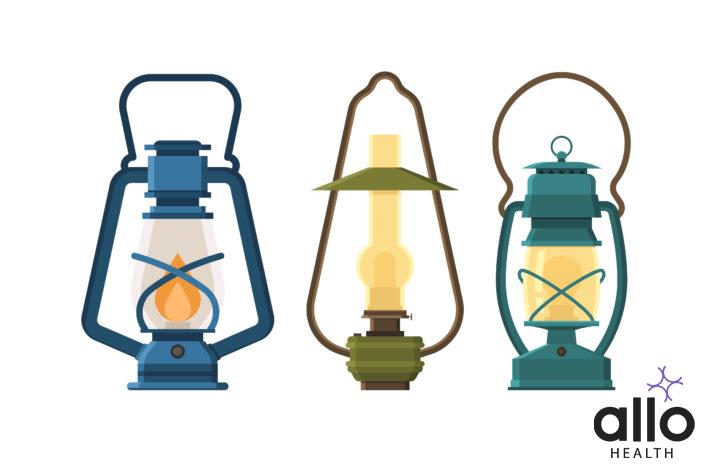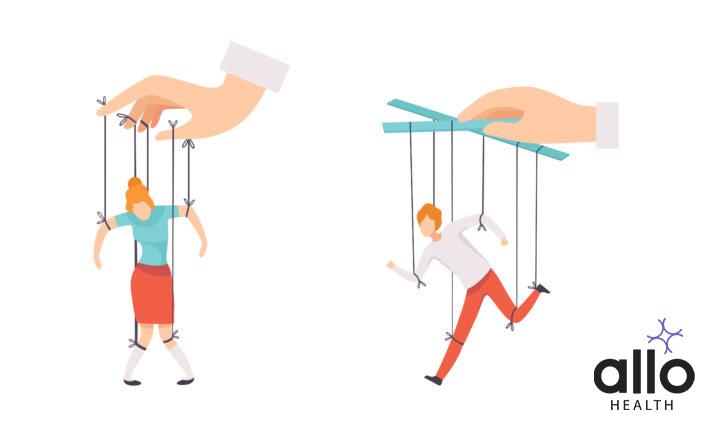Understanding Gaslighting in Relationships: How to Recognize and Respond to It

Allo Health is dedicated to personalized well-being, offering support and trusted information tailored to individual health goals. The platform emphasizes human-generated content, led by a distinguished medical team of experts, including physicians and sexual health specialists. Their commitment to credibility involves rigorous fact-checking, authoritative research, and continuous updates to ensure accurate, up-to-date information. Allo Health's unique approach goes beyond conventional platforms, providing expert-led insights and a continuous commitment to excellence, with user feedback playing a crucial role in shaping the platform's authoritative voice.

Dr Sanina Mansoor holds MBBS degree from Yenepoya university,Mangalore.She has 8 years of experience working as a medical officer at various health centres and medical colleges.
Why This Was Upated?
Our experts continually monitor the health and wellness space, and we update our articles when new information became available.
Updated on 21 February, 2024
- Article was updated as part of our commitment to diversity, equity, and inclusion.

"The following blog article provides general information and insights on various topics. However, it is important to note that the information presented is not intended as professional advice in any specific field or area. The content of this blog is for general educational and informational purposes only.
Book consultation
The content should not be interpreted as endorsement, recommendation, or guarantee of any product, service, or information mentioned. Readers are solely responsible for the decisions and actions they take based on the information provided in this blog. It is essential to exercise individual judgment, critical thinking, and personal responsibility when applying or implementing any information or suggestions discussed in the blog."

Gaslighting Relationships
Gaslighting is a form of emotional abuse that can occur in any type of relationship, including romantic partnerships, familial bonds, and even in the workplace. So when we say gaslighting in a relationship – we are not specifically speaking of romantic relationships. It involves a perpetrator who manipulates and distorts the reality of their victim, causing them to question their own perceptions, thoughts, and memories. Although thFe term “gaslighting” may not be as commonly known as other forms of abuse, it is a very serious form of emotional manipulation that can have long-term effects on a person’s mental health and well-being.
Defining Gaslighting: What It Is and How It Works
Gaslighting is a manipulative psychological tactic used by individuals to gain power and control over others by distorting their perception of reality. The term “gaslighting” originated from a play called “Gas Light” and its subsequent film adaptations, where a husband manipulated his wife into questioning her own sanity by dimming the gas lights in their home and then denying any change had occurred when she noticed it. Gaslighting can occur in various relationships, such as romantic partnerships, friendships, families, or even in larger social contexts.
Gaslighting typically involves a pattern of behavior that aims to undermine the victim’s confidence, memory, and judgment. The gaslighter may employ several strategies to achieve this:
- Denial: The gaslighter denies their actions, emotions, or the events that have taken place. They might assert that something didn’t happen, despite the victim’s clear recollection or evidence to the contrary. By doing so, they make the victim doubt their own perception of reality.
- .False Information: Gaslighters often provide false information or distort facts to confuse the victim. They may intentionally alter details of past events or create entirely fabricated narratives to manipulate the victim’s understanding of the situation. Over time, the victim may become unsure of what is true and what is false.
- Contradiction: Gaslighters contradict themselves or make contradictory statements to confuse the victim. They may assert one thing at one moment and then deny it vehemently later on, causing the victim to question their own memory and judgment.
- Diminishing and Belittling: Gaslighters consistently belittle the victim’s feelings, thoughts, and experiences. They undermine the victim’s self-esteem, making them feel inadequate, unworthy, or overly sensitive. By doing so, the gaslighter gains control over the victim’s emotions and keeps them dependent on validation from the gaslighter.
- Blaming and Shifting Responsibility: Gaslighters often shift blame onto the victim for their own actions or emotions. They make the victim believe that they are the cause of the concerns, thereby deflecting responsibility and maintaining control over the narrative.
- Isolation: Gaslighters isolate the victim from friends, family, or any support network. By limiting the victim’s access to alternative perspectives and external validation, the gaslighter maintains control over the victim’s reality and influences their perception without opposition.
- Gradual Escalation: Gaslighting typically starts subtly and gradually intensifies over time. The gaslighter may begin with small, seemingly harmless manipulations and gradually escalate to more severe tactics. This gradual progression makes it harder for the victim to recognize the manipulation and leaves them more vulnerable to the gaslighter’s influence.
The effects of gaslighting can be significant and detrimental to the victim’s mental and emotional well-being. Victims of gaslighting often experience confusion, self-doubt, anxiety, depression, and a diminished sense of self-worth. They may find it difficult to trust their own judgment, feel constantly on edge, and become increasingly dependent on the gaslighter for validation and guidance.
Recognizing gaslighting is crucial to breaking free from its effects. Victims should seek support from trusted friends, family, or mental health professionals who can provide objective perspectives and help them regain confidence in their own reality.
The Psychology Behind Gaslighting in Relationships

Gaslighting in relationships involves complex psychological dynamics that can have a profound impact on the victim’s perception of reality, self-esteem, and overall well-being. Understanding the underlying psychology behind gaslighting can shed light on why it is so effective and damaging. Here are some key psychological aspects at play:
- Power and Control: Gaslighting is primarily a power and control tactic used by the gaslighter to establish dominance over the victim. By distorting the victim’s reality and making them doubt their own thoughts and emotions, the gaslighter gains a sense of power and control in the relationship. This manipulation allows them to shape the narrative, dictate the terms of the relationship, and ensure the victim’s dependence on them.
- Cognitive Dissonance: Gaslighting induces cognitive dissonance in the victim. Cognitive dissonance refers to the psychological discomfort experienced when a person holds conflicting beliefs, attitudes, or perceptions. When the gaslighter’s actions or words contradict the victim’s understanding of reality, it creates a state of internal conflict. To reduce this discomfort, the victim may be inclined to accept the gaslighter’s version of events or doubt their own judgment, leading to a psychological shift in favor of the gaslighter’s perspective.
- Manipulation of Perceptions: Gaslighters exploit the victim’s vulnerabilities, insecurities, and emotional triggers to manipulate their perceptions. They may initially shower the victim with affection, love, and praise to establish a deep emotional connection. Once this connection is established, the gaslighter gradually introduces manipulative tactics, making it harder for the victim to question their intentions or actions. By playing on the victim’s emotions, the gaslighter can more effectively control their thoughts and behaviors.
- Emotional Manipulation: Gaslighting heavily relies on emotional manipulation. The gaslighter may use guilt, shame, fear, or anger to evoke specific emotional responses in the victim. By strategically triggering these emotions, the gaslighter can further destabilize the victim’s mental state and make them more susceptible to manipulation. Emotional manipulation can be so subtle and insidious that the victim may not even realize they are being manipulated until they are deeply entangled in the gaslighter’s web.
- Dismantling Self-Esteem: Gaslighters systematically erode the victim’s self-esteem and self-confidence. Through constant criticism, belittlement, and invalidation, they make the victim question their worth, abilities, and judgment. The gaslighter aims to create a power imbalance where the victim becomes increasingly dependent on the gaslighter’s validation and guidance. This dismantling of self-esteem strengthens the gaslighter’s control over the victim and can lead to a cycle of emotional abuse.
- Reality Distortion: Gaslighters skillfully distort reality to their advantage. They manipulate facts, memories, and narratives, causing the victim to question their own recollections and sense of reality. Over time, the victim may rely more on the gaslighter’s version of events, accepting their distorted reality as the truth. The gaslighter may also isolate the victim from external sources of information or alternate perspectives, reinforcing their control over the victim’s perception of reality.
- Dependency and Isolation: Gaslighters often strive to create dependency and isolation in the relationship. They may undermine the victim’s relationships with friends, family, or other support networks, making the victim more reliant on the gaslighter for validation, emotional support, and guidance. By isolating the victim, the gaslighter reduces the chances of the victim receiving outside perspectives that could challenge the gaslighter’s manipulation.
Seeking support from trusted individuals, such as friends, family, or therapists, can provide a safe space to process emotions, regain confidence, and develop strategies for asserting one’s own reality and boundaries.
Common Signs of Gaslighting in All Types Relationship
Gaslighting can occur in various types of relationships, including romantic partnerships, friendships, family dynamics, and professional settings. Recognizing the signs of gaslighting is essential to protect yourself from manipulation and maintain your well-being. Here are some common signs of gaslighting:
- Discrediting your perception: Gaslighters often challenge your perception of reality. They may tell you that your thoughts, feelings, or memories are incorrect or exaggerated. They might say things like, “You’re overreacting,” “You’re just being sensitive,” or “That never happened.”
- Constantly questioning your memory: Gaslighters frequently question your memory of past events or conversations. They may deny saying or doing things that you distinctly remember. By making you doubt your own recollection, they undermine your confidence and make you more reliant on their version of events.
- Contradicting themselves: Gaslighters often contradict themselves in order to confuse you. They may say one thing and then later deny ever saying it. This inconsistency creates a sense of uncertainty and erodes your trust in your own judgment.
- Blaming and shifting responsibility: Gaslighters frequently shift blame onto you for their own actions, emotions, or mistakes. They may make you believe that you are the cause of their negative behavior, thereby deflecting accountability and making you question your own worth and culpability.
- Minimizing your feelings: Gaslighters may dismiss or belittle your emotions, making you feel like your feelings are unimportant or invalid. They may say things like, “You’re too sensitive,” “You’re overreacting,” or “You’re making a big deal out of nothing.” By diminishing your emotions, they undermine your self-esteem and manipulate you into doubting your own emotional experiences.
- Withholding affection or approval: Gaslighters often use withdrawal of affection, attention, or approval as a form of punishment or control. They may give you the silent treatment, withhold love or support, or create situations where you constantly have to prove yourself to regain their approval. This tactic keeps you seeking validation and acceptance from the gaslighter.
- Isolating you from support networks: Gaslighters may try to isolate you from friends, family, or other sources of support. They may discourage or undermine your relationships, making you increasingly dependent on them for emotional support and validation. By cutting off external perspectives, the gaslighter maintains tighter control over your reality.
- Twisting facts and distorting the truth: Gaslighters manipulate information and distort facts to fit their narrative. They may selectively present information or present outright lies, making it difficult for you to discern the truth. This deliberate distortion of reality further undermines your confidence in your own perceptions.
- Gaslighting followed by love-bombing: Gaslighters often alternate between gaslighting and love-bombing. After subjecting you to manipulation and emotional abuse, they may suddenly shower you with affection, attention, and praise. This intermittent reinforcement keeps you emotionally invested in the relationship, hoping for the return of the positive behavior and creating a cycle of confusion and dependency.
- Feeling constantly on edge: Gaslighting creates a constant sense of anxiety and unease. You may feel like you are walking on eggshells, constantly second-guessing yourself and fearful of the gaslighter’s reactions. This heightened state of alertness is a result of the psychological manipulation and control exerted by the gaslighter.
How Gaslighting Can Affect Your Mental Health and Well-Being

Gaslighting can occur in various types of relationships, including romantic partnerships, friendships, family dynamics, and professional settings. Recognizing the signs of gaslighting is essential to protect yourself from manipulation and maintain your well-being. Here are some common signs of gaslighting:
- Discrediting your perception: Gaslighters often challenge your perception of reality. They may tell you that your thoughts, feelings, or memories are incorrect or exaggerated. They might say things like, “You’re overreacting,” “You’re just being sensitive,” or “That never happened.”
- Constantly questioning your memory: Gaslighters frequently question your memory of past events or conversations. They may deny saying or doing things that you distinctly remember. By making you doubt your own recollection, they undermine your confidence and make you more reliant on their version of events.
- Contradicting themselves: Gaslighters often contradict themselves in order to confuse you. They may say one thing and then later deny ever saying it. This inconsistency creates a sense of uncertainty and erodes your trust in your own judgment.
- Blaming and shifting responsibility: Gaslighters frequently shift blame onto you for their own actions, emotions, or mistakes. They may make you believe that you are the cause of their negative behavior, thereby deflecting accountability and making you question your own worth and culpability.
- Minimizing your feelings: Gaslighters may dismiss or belittle your emotions, making you feel like your feelings are unimportant or invalid. They may say things like, “You’re too sensitive,” “You’re overreacting,” or “You’re making a big deal out of nothing.” By diminishing your emotions, they undermine your self-esteem and manipulate you into doubting your own emotional experiences.
- Withholding affection or approval: Gaslighters often use withdrawal of affection, attention, or approval as a form of punishment or control. They may give you the silent treatment, withhold love or support, or create situations where you constantly have to prove yourself to regain their approval. This tactic keeps you seeking validation and acceptance from the gaslighter.
- Isolating you from support networks: Gaslighters may try to isolate you from friends, family, or other sources of support. They may discourage or undermine your relationships, making you increasingly dependent on them for emotional support and validation. By cutting off external perspectives, the gaslighter maintains tighter control over your reality.
- Twisting facts and distorting the truth: Gaslighters manipulate information and distort facts to fit their narrative. They may selectively present information or present outright lies, making it difficult for you to discern the truth. This deliberate distortion of reality further undermines your confidence in your own perceptions.
- Gaslighting followed by love-bombing: Gaslighters often alternate between gaslighting and love-bombing. After subjecting you to manipulation and emotional abuse, they may suddenly shower you with affection, attention, and praise. This intermittent reinforcement keeps you emotionally invested in the relationship, hoping for the return of the positive behavior and creating a cycle of confusion and dependency.
- Feeling constantly on edge: Gaslighting creates a constant sense of anxiety and unease. You may feel like you are walking on eggshells, constantly second-guessing yourself and fearful of the gaslighter’s reactions. This heightened state of alertness is a result of the psychological manipulation and control exerted by the gaslighter.
Gaslighting vs. Normal Relationship Conflict: What’s the Difference?
While gaslighting can occur within a relationship, it is important to distinguish it from normal relationship conflict. Understanding the differences can help you identify if you are experiencing gaslighting. Here are some key distinctions between gaslighting and normal relationship conflict:
- Intent: Gaslighting involves intentional manipulation and control tactics aimed at distorting the victim’s perception of reality. The gaslighter purposefully undermines the victim’s confidence, memory, and judgment. In normal relationship conflicts, both parties may have differing perspectives or emotions, but there is no deliberate attempt to manipulate or deceive the other person.
- Pattern of Behavior: Gaslighting is characterized by a consistent pattern of manipulation, distortion, and emotional abuse. The gaslighter employs various tactics repeatedly over time to maintain control over the victim. In normal relationship conflict, disagreements and misunderstandings are typically isolated incidents and not part of a systematic pattern of manipulation.
- Power Imbalance: Gaslighting often involves a significant power imbalance between the gaslighter and the victim. The gaslighter seeks to exert control and dominance over the victim, often by diminishing their self-esteem and making them reliant on the gaslighter’s validation and guidance. In normal relationship conflict, power dynamics may exist, but they are not systematically exploited or used to undermine the other person’s reality.
- Emotional Abuse: Gaslighting is a form of emotional abuse where the gaslighter deliberately invalidates the victim’s emotions, belittles their feelings, and manipulates their emotional responses. Gaslighting can cause significant emotional distress, anxiety, and diminished self-worth. In normal relationship conflict, emotions may run high, but emotional abuse and manipulation are not present.
- Recurrence and Severity: Gaslighting tends to escalate over time and become more severe. The gaslighter may start with subtle manipulation and gradually intensify their tactics. Gaslighting often persists and recurs in various situations. In normal relationship conflict, conflicts may arise periodically, but they are typically resolved or addressed without the consistent and escalating nature of gaslighting.
- Validation and Empathy: Gaslighters often lack empathy and invalidate the victim’s experiences. They may dismiss or minimize the victim’s emotions, memories, and perceptions. In healthy relationship conflict, both parties aim to listen, understand, and validate each other’s perspectives, even if they disagree.
Occasional disagreements and misunderstandings are a normal part of any relationship. However, if you consistently experience the patterns mentioned above, it may indicate gaslighting or emotional abuse. Trust your instincts, seek support from trusted individuals, and consider speaking with a mental health professional to gain clarity and guidance in navigating your relationship dynamics.
Why Some People Are More Vulnerable to Gaslighting Than Others
While anyone can potentially become a victim of gaslighting, certain factors can make individuals more vulnerable to its effects. Here are some reasons why some people may be more susceptible to gaslighting:
- Low Self-Esteem: Individuals with low self-esteem are more likely to doubt their own perceptions and rely on external validation. Gaslighters exploit this vulnerability by systematically eroding their self-esteem and making them more susceptible to manipulation.
- History of Trauma or Abuse: People who have experienced previous trauma or abuse may be more susceptible to gaslighting. Past traumatic experiences can impact their self-confidence, trust in their own judgment, and ability to set boundaries, making it easier for gaslighters to manipulate them.
- Need for Validation and Acceptance: Individuals with a strong need for validation and acceptance may be more susceptible to gaslighting. Gaslighters often begin the manipulation phase by showering the victim with affection, love, and praise. This can be particularly appealing to those seeking external validation and may make them more willing to accept the gaslighter’s distorted reality.
- Lack of Boundaries: People who struggle with setting and maintaining boundaries may be more vulnerable to gaslighting. Gaslighters often push boundaries, ignore personal space, and violate the victim’s autonomy. If an individual lacks the skills to assert their boundaries, they may be more susceptible to the gaslighter’s manipulation.
- Dependence on the Relationship: Individuals who are highly dependent on the relationship, whether emotionally, financially, or otherwise, may be more vulnerable to gaslighting. Gaslighters exploit this dependency to gain power and control, making it harder for the victim to break free from the manipulation.
- Social Conditioning: Societal norms and cultural factors can contribute to vulnerability to gaslighting. Messages that undermine individual autonomy, reinforce gender stereotypes, or discourage assertiveness can make individuals more susceptible to manipulation and gaslighting.
- Lack of Awareness: Gaslighting is a subtle form of emotional abuse, and victims may not initially recognize the signs. Lack of awareness about gaslighting and its tactics can make individuals more susceptible to its effects. Once awareness is developed, individuals can better identify and respond to gaslighting behaviors.
Vulnerability to gaslighting does not imply any fault on the part of the victim. Gaslighters are skilled manipulators who intentionally exploit vulnerabilities for their own gain. Recognizing vulnerability factors can help individuals become more aware of their susceptibility and take steps to protect their well-being.
If you identify with any of these vulnerability factors or suspect you may be experiencing gaslighting, seeking support from trusted individuals, such as friends, family, or professionals, can provide validation, guidance, and help in developing strategies to assert boundaries and protect your mental health.
How to Confront a Gaslighter and Set Boundaries in Your Relationship
Confronting a gaslighter and setting boundaries in a relationship can be challenging, but it’s important to prioritize your well-being. Here are some steps you can take:
- Recognize and validate your experience: Before confronting the gaslighter, it’s crucial to acknowledge and validate your own experiences. Trust your perceptions, feelings, and memories. Understand that gaslighting is a form of emotional abuse, and you have the right to assert your boundaries.
- Educate yourself: Learn more about gaslighting and manipulation tactics to better understand the dynamics at play. This knowledge can help you recognize and counter the gaslighter’s strategies more effectively.
- Seek support: Reach out to trusted friends, family members, or a therapist who can provide support, validation, and guidance throughout the process. Sharing your experiences with someone who understands can be empowering and help you gain perspective.
- Set clear boundaries: Identify the boundaries you want to establish within the relationship. Be clear about what behaviors are unacceptable to you and what you need from the other person. It’s essential to communicate your boundaries assertively, using “I” statements to express your needs and expectations.
- Use assertive communication: When confronting the gaslighter, use assertive communication techniques. Stay calm, composed, and maintain a respectful tone. Clearly express your concerns, feelings, and boundaries without attacking or blaming the other person.
- Document instances of gaslighting: Keep a record of specific incidents where you’ve experienced gaslighting. This documentation can serve as a reference point during the confrontation and help you stay grounded in your reality.
- Stay grounded in your truth: Gaslighters may try to twist or deny the facts to undermine your confidence. Remind yourself of your own truth and rely on your documented evidence to counter their attempts to distort reality.
- Avoid engaging in their tactics: Gaslighters may try to divert or manipulate the conversation by shifting blame, gaslighting further, or using other manipulation tactics. Stay focused on the concerns at hand and your boundaries. Refuse to engage in their manipulative tactics and maintain your assertiveness.
- Establish consequences: Clearly communicate the consequences if the gaslighter continues to disregard your boundaries or engage in gaslighting behaviors. Consequences can vary depending on the situation, such as limiting contact, seeking professional help, or, in severe cases, ending the relationship.
- Prioritize self-care: Gaslighting can take a toll on your emotional well-being. Practice self-care activities that help you stay grounded, reduce stress, and boost your self-esteem. This may include engaging in hobbies, spending time with supportive people, practicing mindfulness, or seeking professional therapy.
The Importance of Seeking Professional Help for Gaslighting Victims
Seeking professional help is crucial for gaslighting victims due to the complex and damaging nature of gaslighting. Here are some reasons why professional assistance is important:
- Validation and Support: Gaslighting victims often doubt their own reality and may struggle with self-doubt and confusion. Seeking therapy provides a safe and non-judgmental space where you can share your experiences and receive validation for your feelings and perceptions. A professional therapist can help you gain clarity, affirm your experiences, and offer emotional support throughout the healing process.
- Guidance and Education: Therapists who specialize in abuse and trauma can provide valuable guidance and education about gaslighting. They can help you understand the dynamics of gaslighting, recognize manipulation tactics, and learn strategies to counteract them. Therapists can also help you develop healthy coping mechanisms and provide tools to rebuild self-esteem and assert boundaries.
- Trauma Recovery: Gaslighting can cause significant psychological and emotional trauma. Trauma-focused therapy, such as cognitive-behavioral therapy (CBT) or eye movement desensitization and reprocessing (EMDR), can help you process and heal from the effects of gaslighting. Therapists can assist you in addressing trauma symptoms, managing anxiety and depression, and developing resilience.
- Rebuilding Self-Esteem: Gaslighting erodes self-esteem and self-worth. Therapists can help you rebuild your self-esteem by challenging negative self-beliefs, exploring your strengths and values, and promoting self-compassion. They can guide you in developing a healthier self-image and reclaiming your sense of self.
- Setting and Maintaining Boundaries: Establishing and maintaining boundaries is crucial in recovering from gaslighting. Therapists can assist you in identifying healthy boundaries, understanding your rights, and practicing assertiveness skills. They can also help you navigate the challenges of setting boundaries within the context of an ongoing relationship or when ending the relationship is not immediately feasible.
- Addressing Co-Occurring concerns: Gaslighting often co-occurs with other mental health challenges such as anxiety, depression, post-traumatic stress disorder (PTSD), or complex trauma. Professional therapists can help you address these co-occurring concerns, providing a holistic approach to your healing journey.
- Safety Planning: In situations where gaslighting involves ongoing abuse or threats to your safety, therapists can assist in creating safety plans. They can provide resources, help you explore options, and guide you in accessing support systems such as domestic violence hotlines, shelters, or legal services.
Remember, therapy is a personal and individual process. It’s essential to find a therapist who specializes in trauma, abuse, or relationship dynamics and with whom you feel comfortable and supported. Professional help can provide invaluable assistance, empowering you to heal, regain your confidence, and establish healthier relationships in the future.
Moving On from a Gaslighting Relationship: Tips for Healing and Recovery
Moving on from a gaslighting relationship requires time, self-care, and intentional healing. Here are some tips to support your healing and recovery process:
- Acknowledge and Validate Your Experience: Recognize that you have been a victim of gaslighting and acknowledge the impact it has had on your well-being. Validate your emotions, perceptions, and the trauma you have experienced.
- Seek Support: Reach out to trusted friends, family members, or support groups who can provide validation, empathy, and a safe space to share your experiences. Consider joining therapy or counseling sessions to receive professional guidance and support.
- Establish No-Contact or Low-Contact: If possible, consider implementing no-contact or low-contact with the gaslighter to create space for healing. This may involve blocking them on social media, changing your phone number, or minimizing direct communication.
- Practice Self-Care: Prioritize self-care activities that promote your well-being, both physically and emotionally. Engage in activities you enjoy, such as exercise, meditation, journaling, spending time in nature, or pursuing hobbies. Focus on self-nurturing and self-compassion.
- Challenge Negative Self-Beliefs: Gaslighting can leave you with negative self-beliefs and self-doubt. Challenge these beliefs by actively replacing them with positive affirmations. Practice self-compassion and remind yourself that you are not to blame for the gaslighter’s actions.
- Set Boundaries: Learn to assert and maintain healthy boundaries in your relationships moving forward. Clearly communicate your needs, expectations, and limits to ensure your emotional and physical well-being is protected.
- Educate Yourself: Learn more about gaslighting, emotional abuse, and healthy relationship dynamics. Understanding the patterns and tactics of gaslighting can help you recognize and avoid similar situations in the future.
- Practice Self-Reflection: Reflect on the relationship and your own experiences. Process the emotions and patterns that emerged during the gaslighting. Consider seeking therapy to gain deeper insight into the underlying factors that may have made you vulnerable to gaslighting.
- Practice Self-Trust: Rebuilding trust in yourself is crucial. Focus on reconnecting with your intuition, listening to your own needs and desires, and trusting your perceptions. Engage in activities that promote self-empowerment and rebuild your self-esteem.
- Surround Yourself with Supportive People: Build a support network of people who validate and uplift you. Surround yourself with friends, family, or a therapist who understand your experiences and can provide support, encouragement, and guidance.
- Practice Forgiveness and Letting Go: Forgiving the gaslighter can be a part of the healing process, but it’s not mandatory. Focus on letting go of any resentment or anger that may hold you back from moving forward. This is a personal journey, and forgiveness may take time or not be applicable in your situation.
- Patience and Self-Compassion: Healing from gaslighting takes time. Be patient with yourself and practice self-compassion throughout the process. Accept that healing is not linear, and there may be ups and downs along the way. Celebrate your progress, no matter how small.
Remember, healing from gaslighting is a deeply personal journey. Be gentle with yourself and give yourself permission to prioritize your well-being. If needed, reach out to a mental health professional who can provide specialized support and guidance as you navigate the healing process.
Understanding the Long-Term Effects of Gaslighting on Your Life
Gaslighting is a form of psychological manipulation that aims to make individuals doubt their own perceptions, memories, and sanity. It involves the deliberate distortion or denial of reality by one person to control or undermine another person’s beliefs or sense of self. The long-term effects of gaslighting can be profound and impact various aspects of a person’s life. Here are some ways gaslighting can affect individuals in the long term:
- Self-Doubt and Confusion: Gaslighting erodes an individual’s trust in their own judgment and perceptions. Over time, victims may start questioning their memory, intuition, and decision-making abilities. They may feel constantly confused, second-guessing themselves, and relying on others for validation.
- Low Self-Esteem: Gaslighting tactics often involve belittling, criticizing, and devaluing the victim. This constant emotional manipulation can lead to a diminished sense of self-worth. Victims may begin to internalize the negative messages and believe they are incompetent, unworthy, or deserving of mistreatment.
- Anxiety and Depression: Gaslighting can contribute to the development or exacerbation of anxiety and depression. The constant emotional manipulation and invalidation can create a state of chronic stress, leading to heightened anxiety. Victims may also experience feelings of sadness, hopelessness, and despair as they struggle to make sense of their reality.
- Isolation and Social Withdrawal: Gaslighters often isolate their victims from friends, family, and support systems. They may discredit the victim’s relationships, making them feel alienated or alone. Over time, victims may withdraw from social interactions, fearing judgment or further manipulation. This isolation can further contribute to feelings of loneliness and vulnerability.
- Difficulty Trusting Others: Gaslighting involves a breach of trust, as victims realize they have been deceived and manipulated. This betrayal can make it challenging for individuals to trust others in the future. They may struggle to discern genuine intentions, fear being deceived again, or become hyper-vigilant about signs of manipulation.
- Emotional Instability: Gaslighting can leave victims emotionally unstable. They may experience intense mood swings, emotional numbness, or difficulty regulating their emotions. The constant gaslighting tactics can lead to a sense of emotional chaos, making it challenging to feel grounded and secure.
- Impaired Decision-Making: Gaslighting undermines an individual’s confidence in their decision-making abilities. The constant questioning and manipulation can make victims doubt their choices and hesitate to assert their needs and preferences. This can result in decision paralysis or an overreliance on others to make choices for them.
- Post-Traumatic Stress Symptoms: In severe cases, gaslighting can lead to symptoms similar to post-traumatic stress disorder (PTSD). Victims may experience flashbacks, nightmares, hypervigilance, and a persistent sense of fear or danger. The psychological trauma inflicted by gaslighting can have a lasting impact on an individual’s mental well-being.
It is important to note that everyone’s experience with gaslighting and its effects may differ. If you have been a victim of gaslighting, seeking support from a mental health professional can be valuable in navigating the healing process and rebuilding self-confidence.
Recognizing Red Flags Before Falling into a Toxic Relationship
Overcoming the trauma of gaslighting is a challenging process, but with self-care strategies, you can empower yourself on the path to healing. Here are some detailed self-care strategies to consider:
- Seek Professional Support: Engaging with a therapist or counselor who specializes in trauma and abuse can provide you with a safe space to process your experiences. They can help you develop coping mechanisms, rebuild self-esteem, and navigate the healing process.
- Validate Your Experience: Gaslighting often makes victims doubt their reality. It’s essential to acknowledge and validate your experiences, emotions, and perceptions. Remind yourself that your feelings are valid, and you have the right to trust your own judgment.
- Establish Boundaries: Setting clear boundaries is crucial in rebuilding a sense of self and protecting your emotional well-being. Practice assertiveness by communicating your needs and preferences to others. Learn to say “no” without guilt and surround yourself with people who respect your boundaries.
- Practice Self-Compassion: Treat yourself with kindness and compassion. Recognize that you were manipulated and that the gaslighting was not your fault. Practice self-care activities that promote self-compassion, such as journaling, meditation, or engaging in hobbies you enjoy.
- Build a Support System: Surround yourself with supportive and understanding individuals who uplift and validate your experiences. Cultivate relationships with trusted friends, family members, or support groups who can provide a safe and empathetic space for you to share your feelings.
- Educate Yourself: Learning about gaslighting, manipulation tactics, and the effects of abuse can help you gain insight and understanding. Educating yourself can empower you to recognize warning signs, break free from self-blame, and take steps toward healing and personal growth.
- Practice Self-Reflection: Engage in self-reflection to understand yourself better and identify any lingering effects of gaslighting. Journaling, therapy, or mindfulness practices can help you explore your emotions, thoughts, and beliefs. Identify negative self-talk patterns and challenge them with positive affirmations.
- Engage in Self-Care Activities: Prioritize self-care activities that promote relaxation, stress reduction, and self-nurturing. Engage in activities that bring you joy, such as hobbies, exercise, spending time in nature, or indulging in creative pursuits. Taking care of your physical and mental well-being is crucial for healing.
- Practice Mindfulness and Grounding Techniques: Mindfulness techniques, such as deep breathing exercises and grounding exercises, can help you stay present and manage anxiety or dissociation. These practices can bring you back to the present moment, allowing you to reconnect with your senses and regain a sense of control.
- Celebrate Your Strength and Progress: Recognize and celebrate your resilience and progress on your healing journey. Acknowledge the steps you have taken, no matter how small they may seem. Celebrate your accomplishments and remind yourself of your strength and capacity for growth.
Remember that healing takes time, and everyone’s journey is unique. Be patient with yourself and practice self-compassion throughout the process. If you find that your symptoms persist or worsen, seeking professional help is essential.
Rebuilding Trust and Confidence After Experiencing Gaslighting in a Relationship
Breaking the cycle of gaslighting and emotional manipulation is important for preventing future trauma. Some strategies for preventing future toxic relationships include setting boundaries and expectations early on, being honest and straightforward about your feelings and needs, seeking out partners who value open and respectful communication, and prioritizing your mental health and well-being. It’s important to remember that healthy relationships are built on mutual respect, honesty, and compassion.
Gaslighting is a serious form of emotional abuse that can have long-term consequences for a person’s mental health and well-being. Recognizing the warning signs of gaslighting, setting boundaries, and seeking professional help can all be important steps in healing and moving forward. Remember, it’s never too late to take control of your own life and prioritize your mental health and well-being.
Another important strategy for preventing future toxic relationships is to take time to reflect on past relationships and identify patterns or red flags that may have led to the toxicity. This can involve seeking therapy or counseling to work through past trauma and develop a better understanding of your own needs and boundaries. It’s also important to be aware of your own behavior and communication style, and to work on improving your own emotional intelligence and empathy.
In addition to individual strategies, it’s important to recognize the role that societal norms and cultural expectations can play in perpetuating toxic relationships. This can include gender roles, power dynamics, and societal pressure to conform to certain relationship norms. By challenging these norms and advocating for more equitable and respectful relationships, we can work towards creating a culture that values healthy and fulfilling relationships for all individuals.






































